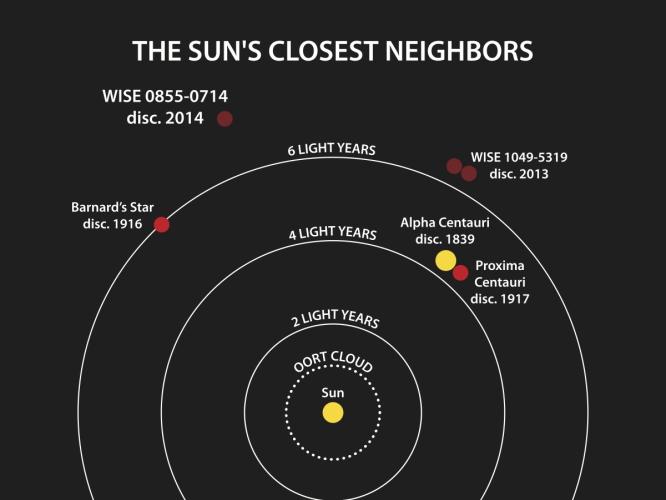Today in science: Proxima Centauri
Deborah Byrd in SPACE | October 12, 2018
Astronomers thought Alpha Centauri was the closest star to Earth. Then they found a smaller, fainter star that’s even closer. They named it Proxima, which means “nearest.”
Our sun’s closest neighbors among the stars, including Proxima Centauri. Image via NASA PhotoJournal.
October 12, 1915. On this date, the Scottish-born astronomer Robert Innes, at the Union Observatory in Johannesburg, South Africa, announced the discovery of what we now know as the next-nearest star to our sun. That star is Proxima Centauri, one of three known stars in the Alpha Centauri system, with the other two stars being Alpha Centauri A and B. He announced his discovery in a paper dated October 12, 1915, titled A Faint Star of Large Proper Motion.
Prior to this announcement, astronomers believed that Alpha Centauri was the closest star to our solar system.
But Proxima – a relatively small red dwarf star – is closer at about 4.24 light-years away.
SAASTA – the South African Agency for Science and Technology Advancement – celebrated Proxima’s centenary in 2015. At its website, SAASTA explained:
Although Alpha had been thoroughly observed by Innes, with his vast experience and passion for observing double stars he suspected that Alpha Centauri might have a companion. While comparing photographic plates that were taken five years apart … Innes observed that a certain faint star had moved. He found that this movement was about the same as that of Alpha Centauri.
After further investigation, he concluded that it was closer to the sun than Alpha. In 1917 he proposed the new star should be called Proxima Centauri, proxima being the Latin word for ‘nearest.’
Today, Proxima remains widely accepted as the closest star to Earth, but it’s still not known for certain whether Proxima is part of the Alpha Centauri system.
The two bright stars here are Alpha and Beta Centauri. The red circle shows the location of Proxima. At
just over one parsec away, it is the closest star to our sun. Sitting in the southern constellation Centaurus
the Centaur, it is most likely gravitationally bound to the bright star on the right: Alpha Centauri. The
other bright star, Beta Centauri, is about 100 parsecs (300 light-years) from Earth. Image via Wikipedia
user Skatebiker.
 |
 |
|
|||||||||||
 |
 |
||||||||||||
|
|
|
|
|
|
|
||||||||
 |
|
|
|
|
|
 |
|||||||
|
|
|
|
|||||||||||
|
|
|||||||||||||
|
|
|
|
|
|
|
|
|
|
|
|
|
|
|
Results 1 to 1 of 1
-
10-12-2018, 12:18 PM #1
Sun’s closest neighbors among the stars, including Proxima Centauri
Beginner's Guide for Rocket, NFPS and IKS66...
http://iptvtalk.net/showthread.php?2...-you-should-do
Kodi Options for Rocket, NFPS and IKS66...
http://iptvtalk.net/forumdisplay.php?71-Kodi
Check the Announcement Section...
http://iptvtalk.net/forumdisplay.php...-Announcements
Similar Threads
-
Closest photos of the Sun ever taken
By ilan in forum The Universe Closer to HomeReplies: 0Last Post: 07-19-2020, 02:33 PM -
Proxima Centauri, the nearest star to Earth
By ilan in forum The Universe in ReviewReplies: 0Last Post: 06-15-2020, 12:15 PM -
What Will The Neighbors Think?....
By bwcbob in forum Jokes/Humor Forum in honor of bwcbobReplies: 2Last Post: 12-07-2019, 02:16 PM -
Omega Centauri globular cluster
By ilan in forum The Universe in ReviewReplies: 0Last Post: 04-23-2019, 12:15 PM -
Mars is closest to the sun today
By ilan in forum The Universe Closer to HomeReplies: 0Last Post: 09-18-2018, 12:12 PM








 Reply With Quote
Reply With Quote